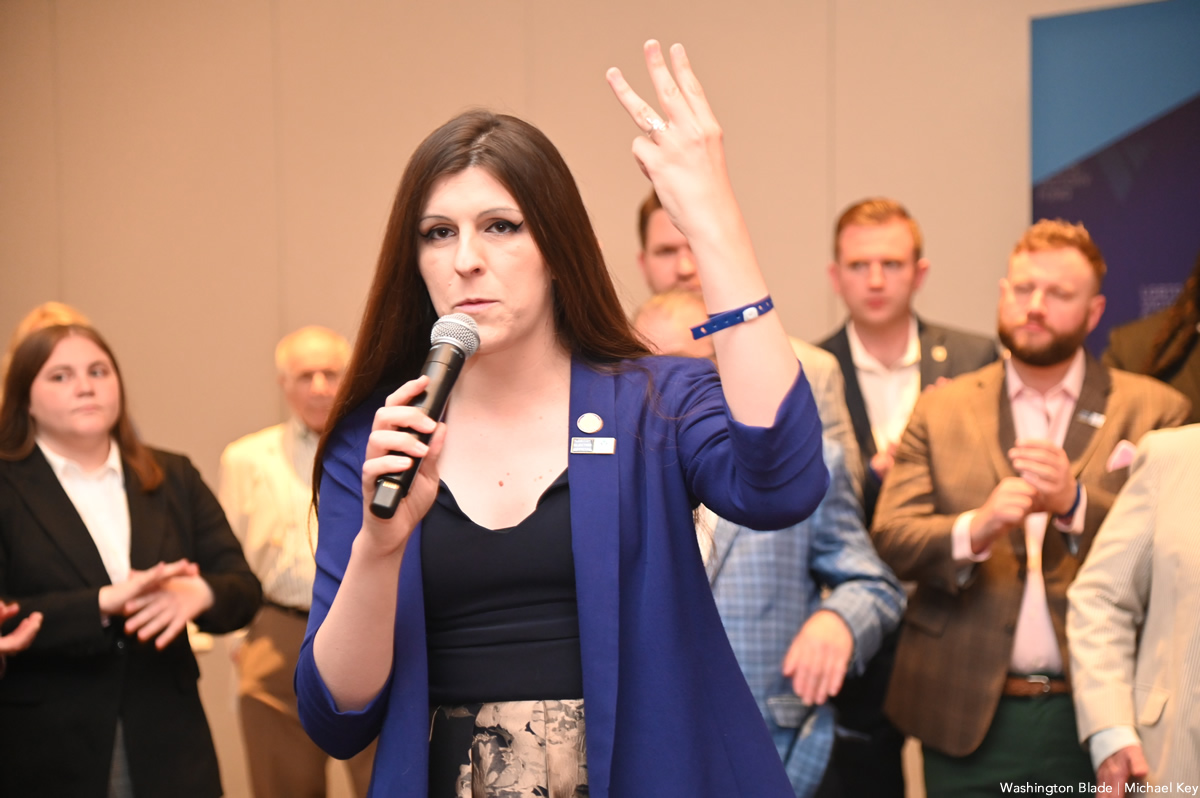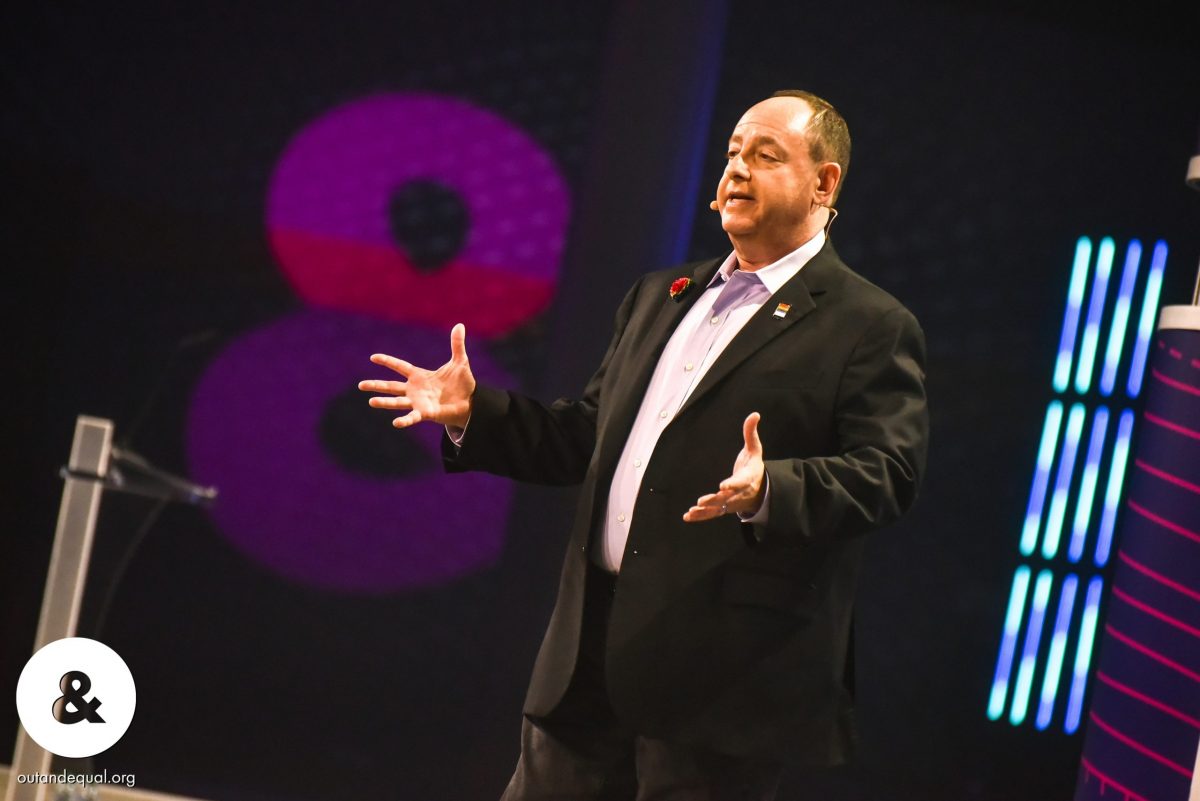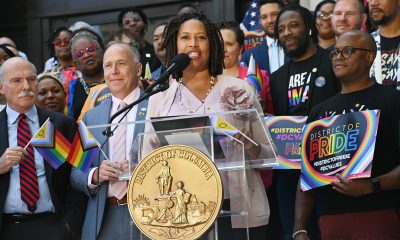Miscellaneous
Stonewall’s lessons for today
Selective use of militant tactics helped the movement to grow

At the time of this significant anniversary it is natural to ask what lessons we can take from the Stonewall Uprising for our time. There is also a natural tendency to hesitate to answer because the Uprising was not only militant but violent, and violence cannot be a usual response to political and social problems in a democracy.
Of course one could focus on the Uprising’s broadest lesson, the value of LGBT people standing up for ourselves, but that is so broad that it is not very helpful in terms of specifics. So what lessons can we draw from this watershed event that are practical and relevant today?
As a historian, I feel that the meanings of Stonewall can be best understood if we look at the Uprising in the broadest context: Why is Stonewall historic and how did the Uprising change the movement?
Stonewall would be at best a footnote to history if it had not inspired a new wave of the gay movement, one that spread rapidly and created a mass movement. I say this since it was the creation of a mass movement by the new phase of the movement that made most of the gains of the last 50 years possible. I feel that the main reason the new movement—the gay liberation movement—spread is that it was militant, unapologetic, and it was very creative at getting in the press in a way that made the movement highly attractive.
For example, as a teenager in high school in Jesup, Ga., I heard about the zaps executed by New York’s Gay Activists Alliance, or GAA. When the city’s marriage bureau said that gay people shouldn’t be allowed to marry, GAA’s members occupied the marriage bureau, chained themselves to the bureau’s desks, and answered the phones by saying that the bureau was only giving out licenses on that day to homosexuals, and then asked, “Are you a homosexual?” When Harper’s published a vicious article attacking gay people and refused to print a response written by gay people, GAA occupied their offices but brought along doughnuts and coffee. The activists approached Harper’s employees saying, “I’m a homosexual. Would you like a doughnut?”
And thus the selective use of militant tactics such as carefully and intelligently planned zaps, boycotts, and civil disobedience when ordinary lobbying has not worked has helped the movement to grow while protecting our community and the rights we have won. For example, when Anita Bryant and her imitators succeeded in overturning laws that banned discrimination on the basis of sexual orientation, gay people and our supporters boycotted orange juice. Bryant subsequently lost her job as the spokeswoman for the orange juice industry. When the federal government did not respond to the AIDS crisis, ACT UP acted up, taking over the FDA headquarters, blocking traffic around Wall Street during rush hour, and conducting die-ins. To awaken the American Psychiatric Association (APA) to the effects of their classification of us as mentally ill, gay activists stormed the convocation during their 1971 national conference. Frank Kameny seized the microphone and declared, “Psychiatry is the enemy incarnate. Psychiatry has waged a relentless war of extermination against us. You may take this as a declaration of war against you.” Before 1973 came to an end, after an intense lobbying campaign, the APA declassified homosexuality as a mental illness.
Two suggestions for applying the lessons of the Uprising to our time:
1. A suggestion for our community on its issues. Donald Trump has been attacking our community. His attacks on us are too numerous to list here, but to mention a few, he wants to take away our right to marry, he has banned trans people from serving in the military, and has revoked the citizenship of the children of gay couples.
It would be appropriate to see a coordinated campaign to oppose all these actions by Trump using not only traditional lobbying and electoral methods, but also by working to gum up the Trump administration. Suppose LGBT people organized a phone-in time on the first day of each month to tie up all of the White House’s phone lines during lunch hour until Trump ended his ban on trans people serving in the military, for example? If Trump does not end the ban, the time could later be expanded to two days a month. And so forth.
I suggest these kinds of direct action tactics because I have been frustrated at the lack of a nationwide campaign that anyone can participate in to express his or her opposition to Trumpism. When I was young, for example, it meant a great deal to me to participate in the Moratorium events organized to oppose the war in Vietnam.
Could a number of LGBT state and national organizations come together and forget about their disagreements about how to oppose Trump, and instead focus on the goals they agree upon. With agreed upon goals, they could then determine what tactics — actions that any citizen could do on her or his own — could work toward meeting those goals. They could look at ACT UP and GAA, for example, for inspiration. Want to help block traffic this Friday? Want to tie up Senate Republican phone lines this coming Monday?
2. A suggestion for all Americans about our country’s future. Could national organizations of all stripes that oppose Trump’s policies meet and put aside their differences and focus instead on what they can agree upon? More specifically, could they focus on tactics for either changing Trump’s policies or removing Trump from office? I think that if the American people, the majority of whom disapprove of Trump, had a menu of actions they could take against the Trump administration that anyone could do, a great many would act. One reason I believe this is that it boosts one’s morale to feel that one is acting in concert with others toward a common goal. Also, such a broad campaign would garner significant media attention, which would then reach and energize more of Trump’s opponents.
For example, an anti-Trump coalition could announce a campaign that, on the first Monday of every month, citizens who oppose Trump would not spend any discretionary funds: no going to see a movie or buying oneself a new tie or a pair of earrings or a book on that day. Instead the money one would have spent for pleasure would be donated to the anti-Trump coalition. Or the coalition could suggest that people who drive tie up traffic by driving slowly on the way to work on the first Tuesday of each month. And what if Trump doesn’t change the policies the coalition is demanding that he change? The traffic slow down could be moved to Friday to have more impact.
Of these two suggestions, I recommend the second one. I say this because I believe with many others that the Trump presidency constitutes an existential crisis for our republic. Moreover, the LGBT civil rights movement is strong enough now that we can afford to think beyond our own immediate needs. I would love for us to call for all anti-Trump organizations to send a delegate to a national meeting with each delegate being empowered to vote. I envision such a national meeting’s purpose as being to set a common agenda with common tactics designed to remove Trump from the Oval Office: to draw up a list of grievances and a declaration about how to address those grievances through a common plan of action. Wait, isn’t this rather like the way in which our country was founded? Yes, it is. And I believe that it is time for revolutionary action to oppose the counter-revolution led by Trump.
(David Carter and the Washington Blade give universal permission to copy and reprint this editorial as long as Donald Trump occupies the Oval Office.)
David Carter is author of ‘Stonewall: The Riots that Sparked the Gay Revolution.’
Miscellaneous
Stephen Miller’s legal group sues Fairfax County schools
Lawsuit challenges policies for transgender, nonbinary students

Former Trump administration official Stephen Miller’s legal group on Tuesday filed a lawsuit against the Fairfax County School District over its policies for transgender and nonbinary students.
America First Legal in a press release notes it filed the lawsuit against the school district on behalf of a female, “practicing Roman Catholic” student “for allowing teenage boys to use the female restrooms and for forcing a radical, government-sponsored gender indoctrination and approved-speech scheme that discriminates against students on the basis of sex and religion and violates their free speech rights under the Virginia Constitution.”
The lawsuit was filed in Fairfax County Circuit Court.
The Virginia Department of Education last July announced new guidelines for trans and nonbinary students for which Republican Gov. Glenn Youngkin asked. Equality Virginia and other advocacy groups claim they, among other things, would forcibly out trans and nonbinary students.
Fairfax County schools are among the school districts that have refused to implement the guidelines.
“Fairfax County Public Schools appears to believe that its policies and regulations can override the Virginia Constitution’s protections for religious beliefs, speech and from government discrimination on the basis of sex and religious beliefs,” said America First legal Senior Advisor Ian Prior in a press release. “It is well past time for FCPS to stop sacrificing the constitutional rights of its students so that it can implement a state-sanctioned ideology that demands compliance in speech, beliefs and conduct.”
FCPS Pride, a group that represents the Fairfax County School District’s LGBTQ employees, described the lawsuit as “abhorrent.”
“We are confident that the school board and the superintendent will strongly and firmly oppose this specious suit and continue to support all students, including transgender and gender expansive students,” said the group in a press list.
Miscellaneous
More than a dozen LGBTQ candidates on the ballot in Va.
Control of the state Senate hangs in the balance

More than a dozen openly LGBTQ candidates are on the ballot in Virginia on Nov. 7.
State Del. Danica Roem (D-Manassas) is running against Republican Bill Woolf in the newly redistricted Senate District 30 that includes western Prince William County and the cities of Manassas and Manassas Park.
Roem in 2018 became the first openly transgender person seated in a state legislature in the U.S. after she defeated then-state Del. Bob Marshall, a prominent LGBTQ rights opponent who co-wrote Virginia’s constitutional amendment defining marriage as between a man and a woman. Roem would become Virginia’s first out trans state senator if she defeats Woolf.
Woolf supports a bill that would require school personnel to out trans students to their parents. The Republican Party of Virginia has highlighted this position in ads in support of Woolf.
“Thank you for reminding me why I won three elections in this district in Prince William County, which is the most diverse county in all of Virginia and the 10th most nationally where we welcome everyone because of who they are, not despite it, no matter what you look like, where you come from, how you worship, if you do, or who you love because you should be able to thrive here because of who you are, never despite it,” said Roem on Sept. 28 in response to a woman who heckled her during a debate with Woolf that took place at Metz Middle School in Manassas.
Gay state Sen. Adam Ebbin (D-Alexandria) is running for re-election in Senate District 39. State Del. Mark Sickles (D-Fairfax County), who is also gay, is running for re-election in House District 43.
Former state Del. Joshua Cole, who identifies as bisexual, is running against Republican Lee Peters in House District 65. State Del. Kelly Convirs-Fowler (D-Virginia Beach), who came out as bisexual last year at Hampton Roads Pride, will face Republican Mike Karslake and independent Nicholas Olenik.
State Del. Marcia “Cia” Price (D-Newport News), a Black woman who identifies as pansexual, is running for re-election in House District 85.
Adele McClure, a queer Democrat, is running to represent House District 2 that includes portions of Arlington County. Laura Jane Cohen, a bisexual woman who is a member of the Fairfax County School Board, is a House of Delegates candidate in House District 15.
Rozia Henson, a gay federal contractor who works for the Department of Homeland Security, is running in House District 19. Zach Coltrain, a gay Gen Zer, is running against state Del. Barry Knight (R-Virginia Beach) in House District 98.
LPAC has endorsed Jade Harris, a Rockbridge County Democrat who is running to represent Senate District 3. Harris’ website notes trans rights are part of their platform.
“Protecting trans rights, repealing right to work, strengthening unions and supporting our farmers are just a few of my legislative priorities,” reads the website. “I am dedicated to addressing the revitalization of our state’s infrastructure, fostering a favorable environment for job creation, and supporting our public education system.”
Republicans currently control the House by a 51-46 margin, while Democrats have a 21-19 majority in the state Senate.
Senate Democrats have successfully blocked anti-LGBTQ bills that Republicans have introduced since Republican Gov. Glenn Youngkin took office in January 2022.
The Virginia Department of Education in July released new guidelines for trans and nonbinary students that activists and their supporters have sharply criticized. They fear that Republicans will curtail LGBTQ rights in the state if they regain control of both houses of the General Assembly on Nov. 7.
“Time and time again, anti-equality lawmakers and the Youngkin administration have made it clear that they will continue to disrespect and disregard the lives and lived experience of LGBTQ+ people within Virginia,” said Equality Virginia PAC Executive Director Narissa Rahaman in August when her organization and the Human Rights Campaign endorsed Roem, Ebbin and other “pro-equality champions.”
“We must elect pro-equality champions who will secure and strengthen our freedoms,” added Rahaman. “We have that chance as the eyes of the nation are on us this November.”
The LGBTQ+ Victory Fund has endorsed Fairfax County School Board Vice Chair Karl Frisch and Fairfax County School Board candidates Robyn Lady and Kyle McDaniel, who identify as lesbian and bisexual respectively.
Michael Pruitt would become the first openly bisexual man elected to the Albemarle County Board of Supervisors if he were to win on Nov. 7. Blacksburg Town Councilman Michael Sutphin and Big Stone Gay Town Councilman Tyler Hughes, who are both gay, are running for re-election.
“Tyler will be a critical voice for equality as the only out LGBTQ+ person on the Big Stone Gap Town Council,” says the Victory Fund on its website.
Cal Benn contributed to this article.
Miscellaneous
What it means to be an active ally to your LGBTQ+ co-workers TEST
Five easy tips to help you avoid common risks

Your home is more than just a place to eat and sleep; it’s your safe haven. As much as you might cherish your home, you should probably also recognize the potential hazards within its familiar walls. Accidents can happen in an instant, yet with a little foresight and some simple adjustments, you can transform your house into a safer haven.
Accidents can happen anywhere, and with a few simple tweaks, you can lower risks in your space. Below you’ll find five tips for each room in your home to help prevent injuries, falls, and other mishaps. In short, home safety.
This article was inspired by a shower in a rental we managed that began leaking through the kitchen ceiling below. If only the landlord had installed grab bars, right!? Below, we’ll guide you through the steps to fortify your bathroom, making it a place of relaxation without the fear of slips and falls. Then, we’ll venture into the room where the magic happens, where proper planning can ensure great nights and peaceful mornings. We’ll show you how to prevent accidents while you experiment becoming the next Gordon Ramsey. And we’ll include a few surprising solutions for those other rooms that hold their own unique hazards, offering solutions to safeguard against unexpected mishaps.
Bathroom Safety
Install Grab Bars: Adding grab bars near the shower and toilet can provide essential support for family members of all ages. Not only can they help with getting in and out, but they can help provide stability when washing. Make sure they are securely anchored to the wall.
Non-Slip Mats: Place non-slip mats inside the shower and bathtub to prevent slips. They’re a small investment that can save you from falls and head injuries.
Adjust Water Temperature: Ensure your hot water is set to a safe temperature to avoid scalding. The hot water heater should be set to around 120°F (49°C)l, the middle setting on many water heater settings.
Medicine Cabinet Locks: If you have young children, use childproof locks on your medicine cabinet to keep harmful substances out of reach.
Proper Lighting: Ensure there’s adequate lighting in the bathroom to avoid trips and falls during nighttime visits. Nightlights can be a simple and effective solution.
Bedroom Safety
Clear Pathways: Keep pathways in the bedroom clutter free to prevent tripping. Ensure there’s enough space to move around comfortably, particularly getting around the bed. Be aware where all furniture is when walking around to avoid stubbed toes, particularly at night.
Secure Rugs: If you have throw rugs, use rug grippers or double-sided tape to keep them from slipping. Loose rugs are a common trip hazard.
Bed Rails: For anyone at risk of falling out of bed, consider installing bed rails to provide extra support and prevent falls.
Nightstands with Drawers: Opt for nightstands with drawers to keep essential items. This reduces the need to get out of bed at night, minimizing the risk of falls, as you race to grab what you need and not lose a moment’s rest.
Fire Safety: Install battery-operated smoke detectors in the bedrooms if there are none. Make sure to install them 36 inches away from an air vent or the edge of a ceiling fan. Also six inches away from the joint between the wall and ceiling. And test smoke detectors regularly.
Kitchen Safety
Non-Slip Flooring: Choose slip-resistant rugs in the kitchen, especially in areas where spills are common. Mats near the sink and stove can also help and you can often buy them fairly cheaply at Costco.
Childproof Cabinets: If you have little ones, use childproof latches on cabinets and drawers to prevent them from accessing potentially hazardous items.
Anti-tip brackets: Install an anti-tip bracket behind the range. These are often used when children are in the home. Although they are less likely to open the oven door and use it as a step stool to get to the stove-top, adults can also benefit from installing these.
Adequate Lighting: Proper lighting is crucial in the kitchen to avoid accidents. Under-cabinet lighting can illuminate work areas effectively.
Secure Heavy Items: Ensure heavy pots and pans are stored at waist level to prevent straining or dropping them from high shelves.
Sharp Object Storage: Keep knives and other sharp objects in a secure drawer or block. And handle all sharp items with extreme care, even when washing and drying. These steps reduce the risk of accidental cuts.
Other Safety Tips
Furniture Anchors: Secure heavy furniture, like bookshelves and dressers, to the wall to prevent tip-overs, especially if you have young children.
Adequate Outlets: Check for damaged outlets and replace them promptly. Avoid overloading circuits with too many devices. Install placeholder plugs in outlets to prevent young curious fingers (or tongues?) from going inside an electrical outlet.
Stair Gates: If your home has stairs, install safety gates at the top and bottom to prevent falls, especially if you have toddlers or pets to keep them off of the stairs when you cannot monitor them.
Emergency Escape Plan: Develop and practice an emergency escape plan with your family, including a designated meeting place outside.
Carbon Monoxide Detector: If your home burns any fossil fuels for heating or appliances, install carbon monoxide detectors in common areas of your home to detect this odorless gas. The D.C. building codes require this if you use a fireplace or if you have an attached garage. In essence, if there is any potential source of carbon monoxide in the home, be sure to install these detectors.
Remember, a safer home not only prevents accidents but also provides peace of mind for you and your family. Implement these simple tips to create a secure environment in every room of your house.
With these practical tips and a few adjustments, you can significantly reduce the risk of injuries and falls in your home. Enjoy peace of mind in your now much safer haven.
Scott Bloom is owner and senior property manager of Columbia Property Management.
-

 State Department5 days ago
State Department5 days agoHIV/AIDS activists protest at State Department, demand full PEPFAR funding restoration
-

 Brazil5 days ago
Brazil5 days agoUS lists transgender Brazilian congresswoman’s gender as ‘male’ on visa
-

 District of Columbia5 days ago
District of Columbia5 days agoCapital Pride wins $900,000 D.C. grant to support WorldPride
-

 Obituary4 days ago
Obituary4 days agoLocal attorney, LGBTQ rights advocate Dale Sanders dies at 75










